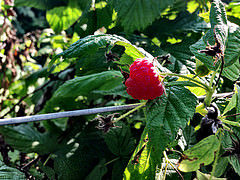2 pints blueberries
1 half-pint raspberries
half dozen eggs
2 bags tomatoes
1 dozen ears corn
1 heirloom cantaloupe
1 bag of dried white onions
2 eggplant
2 bags Yukon gold potatoes
1 bag sweet Italian frying peppers
**OPTIONAL BONUS** 2 half-pints pick-your-own raspberries, from 8 a.m. until noon, CSA members only
Total retail value of goods in this week’s box: $58
Total retail value of goods distributed so far this year: $653.50
Emily’s notes:
The onions in this week’s box are dried, and will keep longer than the spring onions distributed so far this year. If you keep them in a cool, dry, place, you could use them any time in the next several months!
I’m a big fan of roasting eggplants, either whole on the grill or in the oven, or sliced lengthwise, as The New York Times suggests here. As the Times says, and as I have found, if you try to fry or sautee eggplant slices in oil, they will quickly soak up every bit of oil in your pan like a sponge, and then you’ll end up ingesting all that extra fat in the finished dish. When you roast, the eggplant naturally becomes softer and more flavorful. With the onions, tomatoes and eggplant in this week’s box, I’d suggest trying this recipe for Eggplant Tomato Gratin. For a simpler preparation that can be served at lunch, dinner or snacks, try this technique I detailed last year:
I threw the whole eggplant on the grill for about 25 minutes total, let it cool a bit, peeled it and let the water drain out in a colander in the sink for about 10 minutes. I roughly chopped the cooked eggplant and added about a quarter-cup of chopped basil, a tablespoon of tahini, the juice of one lemon, one chopped garlic clove and salt and pepper. I meant to add olive oil, but it never happened, and I didn’t miss it. I beat this mixture up with a wooden spoon until all the flavors had melded. It was great atop fresh-made homemade pizza the first night. The second night I used it as a dipper for cheese-and-corn quesadillas. I highly recommend throwing your whole eggplant on the grill, burning its skin and then using the cooked inside with whatever flavorings your heart desires. Even just simple olive oil, lemon juice, salt and pepper wouldn’t be bad.
Eggplant and tomatoes together get me thinking about panzanella, an Italian salad that uses stale crusty bread (you will want good bread for this, not the flimsy-crust stuff). A salad like this can be anywhere on the spectrum from extremely simple to much more involved. I have thrown together panzanella before by tossing chopped tomatoes with the bread and a bit of salt and pepper. While that sits and “marinates,” I’ll roast some cubed eggplant in olive oil and seasonings in a 450-degree oven for 15-25 minutes. You could throw chopped onions onto the roasting pan, as well. Toss everything together with some olive oil, balsamic vinegar and more salt and pepper to taste, and add some chopped parsley or basil and chunks of a cheese like parmesan, mozzarella, pecorino, feta or chevre, depending on what you have. Williams-Sonoma, however, has a much more detailed recipe here for a grilled eggplant, corn and tomato panzanella that looks delicious.
Italian frying peppers are mild, thin-walled peppers that aren’t great for oven-roasting, but do lend themselves to frying and sauteeing. They would be excellent served aside grilled sausage prepared according to this recipe for cast-iron charred peppers with parmesan.
I’ve been disappointed with many a recipe for blueberry muffins, but last week I made this one from celebrated cookbook author Mollie Katzen. It produced the fluffy, not overly sweet muffin I was looking for, and I highly recommend it.




